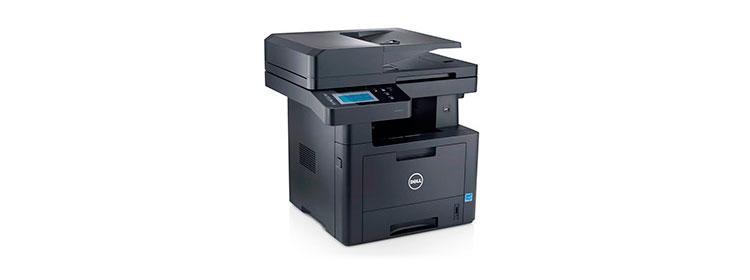Meant for light- to medium-duty use in a mid-size office or workgroup, but also a good fit for heavy-duty use in a small office, the Dell Mono Multifunction Printer – B2375dnf delivers on both multifunction printer (MFP) basics and convenience features, like its touch-screen control panel. It isn’t as fast on our tests as you might expect from its 40 page-per-minute (ppm) rating. In fact, the Editors’ ChoiceOKI MB471, is faster despite a slower rating. The Dell printer is fast enough, however, so speed shouldn’t be an issue, and it offers enough overall to make it a potentially good choice.
The B2375dnf starts with a full set of MFP basics. It can print and fax from as well as scan to a PC, including over a network, and it can work as a standalone copier, fax machine, and direct email sender. It can also print from and scan to a USB memory key. Even better, it’s 4.3-inch touch screen and menus make it reasonably easy to use for copying, faxing, and email, although the touch screen is a little less responsive than it could be for scrolling through the choices.
Paper Handling and Other Basics
Paper handling is a big part of what limits the printer to light to medium-duty use by mid-size office standards. It comes with a 250-sheet paper drawer, a 50-sheet multi-purpose tray, and an automatic duplexer (for two-sided printing) standard. You can also add a 520-sheet second drawer ($149.99 direct), for a total 820-sheet capacity. If you need more than that, however, you’ll have to look elsewhere.
Paper handling for scanning is similarly one step short of being suitable for heavy-duty use. The letter-size flatbed is supplemented by a 50-page automatic document feeder (ADF), which can handle up to legal-size paper for copying, scanning, faxing, or email. Even better, the ADF can duplex, by scanning one side, turning the page over, and then scanning the other.
Combined with duplex printing, the duplexing ADF lets you copy both single and double-sided originals to your choice of single or double-sided copies, which is obviously a welcome convenience. However, it isn’t as desirable, or as fast, as scanning in duplex, meaning both sides of the page at once.
One other notable convenience is mobile printing support. If you connect the printer to your network, you can both print through the cloud (assuming the network is connected to the Internet) and print over Wi-Fi from iOS and Android phones and tablets (assuming you have a Wi-Fi access point on your network).
Note that the printer itself doesn’t offer Wi-Fi. If you want a printer that can connect wirelessly, you can get the Dell Mono Multifunction Printer – B2375dfw, which sells for the same list price. According to Dell, the two models are otherwise identical, which means almost all of the comments in this review should apply to both. Keep in mind, however, that printing over Wi-Fi will probably give you a different speed than printing with the Ethernet connection I used for testing.
Setup, Speed, and Output Quality
As is typical for this class of printer, the B2375dnf is far too big to share a desk with comfortably, but small enough, at 18.8 by 18.2 by 16.5 inches (HWD), so you shouldn’t have too much trouble finding room for it even in a small office. Setting it up on a network, with drivers installed on a Windows Vista system, was standard fare.
As I’ve already mentioned, the printer was slower than expected in my tests. Dell rates it at 40 pages per minute (ppm), which is the speed you should see for text documents with little to no formatting. I clocked it on our business applications suite (using QualityLogic’s hardware and software for timing), at just 5.9 ppm.
As one point of comparison, when I reviewed the OKI MB471, which is rated at 35 ppm, I pointed out that its 9.5-ppm speed on our tests qualified as respectable, but not particularly impressive. Other printers do far better compared with their ratings. The 24-ppm Canon imageClass MF4770n, for example, came in at 12.3 ppm on our tests.
Output quality for the B2375dnf is absolutely typical, with text, graphics, and photos each falling within a tight range that includes the vast majority of mono laser MFPS. For text, that translates to being easily good enough for virtually any business need, but a little short of what you’d want for serious desktop publishing applications.
Graphics output is similarly good enough for any internal business need. Depending on how critical an eye you have, you may also consider it good enough for PowerPoint handouts and the like. Photos are good enough for printing recognizable images from Web pages, which is about as much as you can expect from a mono laser.
Also demanding mention is that the B2375dnf offers other useful conveniences, including private printing, for example, which lets you send a job to the printer, but not print it until you enter a password through the front-panel touch screen.
If what you need in a printer is fast speed, high input capacity, or above-par output quality, you’ll obviously need to look elsewhere. What keeps this printer in the running, however, is its long list of conveniences, from private printing to scanning to a USB key, along with its full set of MFP basics—for printing, scanning, copying, faxing, and email. If you need those MFP features more than raw print capability (meaning speed, output quality, and paper handling), the Dell Mono Multifunction Printer – B2375dnf can be a highly attractive choice and could easily be the right fit for your office.







